|

by E. Vegh
2006
from
TheLivingRoom Website
Self-education is, I firmly
believe, the only kind of education there is.
- Isaac Asimov
Scientist, Author
Introduction
I think a future flight should
include a poet, a priest and a philosopher. We might get a
much better idea of what we saw.
- Michael Collins
Apollo Astronaut
Ancient history is a labyrinth of
immense proportions.
Time and distance appears a nearly
insurmountable barrier to discovery in many ways. However,
weaved throughout the millennia of monuments, megaliths,
pyramids and mythological texts, is a thread that bridges the
years and allows us to see the events of ancient times with the
clarity of hindsight.
This hindsight has only been dimmed
in the past few centuries, by the accumulation of "educated"
presumptions, no doubt a result of learning from the same text
books, the same theories, the same arguments and the same
methods. Nothing could be less revealing or more debilitating to
discovery.
As a result, this book will deal primarily with fresh
and alternative perspectives on old mysteries, taking up that
thread through the labyrinth of the ancient past and sharing
with the reader, where it leads.
For example, many of the ancient monuments appear to be
intimately connected in a surprising number of similar ways. The
similarities so far outweigh the differences, that the honest
discoverer is compelled to ask: How can this be a coincidence?
The question is answered shortly
thereafter, with yet more confirmation of intimacy, found in the
mythological and historical texts from that long ago time.
Such texts are the voices of those
who built the megaliths,
pyramids and ziggurats (or at the very
least, assisted in the endeavors), and as such, their words
should be afforded the same respect as the towering monuments,
themselves.
This book will attempt to allow our ancestors at
least that small dignity.
In addition, revealing and uncovering the thousands of
similarities between the ancient monuments, lead to new theories
and new insights. One such discovery occurred while revisiting
an old theme, that of the biblical and Sumerian flood. It
appeared a sort of technological and ancestral amnesia had
suddenly and simultaneously descended on most of the near,
middle and far east, around 3500 BC.
The two eras, pre- and post-flood,
had to be clearly delineated so the writings of the ancient past
could be best understood. Nowhere was this information more
readily available than in the writings of the ancient people of
Sumer,
Egypt, India and Akkadia. This pivotal moment in history
became a reliable anchor and repository of ancient information
in an otherwise, overwhelming silence.
What I discovered was nothing short of astounding:
Ancient humans had not only been
visited and assisted by the "gods," they often told their
human subjects stories of their arrival to our planet, using
terminology their listeners could understand.
They recounted amazing tales
through human scribes, tales of technology that would allow
them to visit other planets, places and dominions, by simply
passing through "gates" or via star-fairing ships.
Our ante-diluvian ancestors also
witnessed this astounding technology, technology that today we
most closely associate with
stargates,
wormholes, lasers,
cloning,
recombinant DNA,
space craft, nuclear and
teleportation
devices.
Then something went terribly wrong.
The flood arrived and the resulting cataclysm laid waste to the
earth-based civilizations of the "gods". When the waters abated,
many of the old gods were gone, as well. Their stargates had
been swallowed up by the earth, and only scattered remnants of
human survivors remained to remember their tales, their deeds
and their technology.
At that crucial moment in human history, following the flood, is
where we pick up the thread and begin to unravel the mystery of
the ancient days of planet Earth. With the help of reverse
engineering and comparative analysis, we will attempt to
rediscover, together, the old gods and their devices, in their
hiding places.
Armed with this new information, it
is my hope that the rest of ancient history will begin to take
shape for the reader, from an entirely new perspective. Perhaps,
what was once a marginally understandable series of fantastic
stories from the ancient past, will become crystal clear,
startling revelations.
Truth is stranger than fiction.
E.Vegh
January, 2006
"Deep Space"
Some consider the phrase, "As above, so
below," to have magical implications.
But what if the meaning was, originally,
something quite different? What if knowledge of the ancient past has
been so entrenched in long forgotten meanings and half-hidden
symbols, that we've inadvertently misconstrued the interpretation of
those symbols?
Let's consider one such symbol: the
hourglass shape.

It is the visual embodiment of "As
above, so below."
Scientifically, only physics effect its
application and change its meaning. It will be a major theme of this
book and for good cause: it's found throughout ancient history,
particularly in religious art-forms and almost always in connection
with the gods. However, to do the subject justice, we need to start
at the beginning.
THE BEGINNING...
Once upon a time in the land of ancient Sumer [1], in
what is now modern day Iraq, there was a city called "Eridu."
It was
the first known civilization (to date). It sprung up from seemingly
nowhere, having been previously and intermittently inhabited by
wandering nomads and hunter-gatherers.
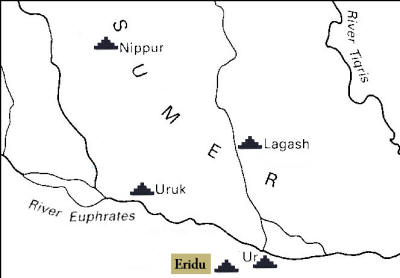
Map of Sumer
It was presided over by the Anunnaki
"god," Enki.
He was not only its ruler, he was also
its designer and founder. His throne and abode, called the "E.ABZU"
or "E.ENGURRA", was the first ziggurat ever built (to our knowledge)
and had several unique features, frequently overlooked by readers of
the ancient Sumerian texts. For example, it was made of silver
"bricks," covered in gold, produced roaring sounds, and its walls
could talk and offer advice.
And, if that weren't enough, it could
also float on the water and hover in the air!
Observe the following quotes from "Enki
and the World Order":
An artfully made bright crenellation
rising out from the abzu was erected for lord Nudimmud. Enki,
the lord who determines the fates, built up his temple entirely
from silver and lapis lazuli. Its silver and lapis lazuli were
the shining daylight. [...]
Your door is a lion who {seizes a man} [...]
Its brickwork makes utterances and gives advice. [...]
He built the temple from precious metal, decorated it with lapis
lazuli, and covered it abundantly with gold. [...]
As it has been built, as it has been built; as Enki has raised
Eridug up, it is an artfully built mountain which floats on the
water. [4]
Samuel Noah Kramer, an
assyriologist who was the first to translate many of the Sumerian
texts, said in his book "Enki Builds the E-Engurra":
The lord of the abyss, the king Enki,
Enki the Lord who decrees the fates, Built his house of silver
and lapis lazuli; Its silver and lapis lazuli, like sparkling
light, The father fashioned fittingly in the abyss.
[...]
Then Enki raises the city of Eridu from the abyss and makes it
float over the water like a lofty mountain.
This would all seem harmless enough,
were Enki's story a fairy tale about a fictitious place.
But in
fact, it was quite real. Eridu was a real city in ancient Sumer, and
Enki's E.ABZU was a real... building (that apparently defied the
laws of gravity in 4000 BC!).
Obviously, a "building" made of silver
and covered with gold, would sink immediately (if not sooner) and
therefore, could not float on the water or above it, for that
matter. Alas, this amazing feat of architectural (or mechanical)
engineering has vanished, being either a victim of the Mesopotamian
flood, the vengeance of God, thievery, the spoils of war, or has
long since launched itself into space (why not? It could do
everything else!)!
Equally unusual was Enki's boat, which apparently needed no oars:
"The ship departs of its own accord,
with tow rope held (?) by itself" [2] and it gurgles
as it moves down the river.
Yes, this Enki sure is an interesting
character, isn't he? And we're just getting started!
By far the most mysterious of Enki's properties was the "ABZU" (also
called "Apsu"). The ABZU was underneath the E.ABZU when it was on
dry land, that is, it was a subterranean chamber under the spot
where Enki parked his ziggurat in Eridu, a basement of sorts.
Enki and the other "gods," frequently
met there to discuss important matters. Oddly enough, it's also
referred to as an underground chamber of "sweet" or "fresh" water, a
water vessel for temple rituals, the abyss, the bottomless pit, the
deep, and in the
Enuma Elish, Abzu was a god from which the gods and
sons of god, emerged.
All these concepts don't appear to have
much in common on first glance, but they actually apply to different
aspects of the ABZU, which is why it has been so terribly
misunderstood as an ancient symbol.
Note and remember for future reference, that Samuel Noah Kramer had
already translated the word Abzu to be Abyss, meaning that the Abzu
and the Abyss were one in the same. In fact, it is my contention
that the word "Abzu" was the etymological origin of the word
"Abyss."
Thusly, Enki's E.ABZU, his E-ENGURRA,
his ziggurat, rose up out of the Abzu, already completed, and
floated above the water.
Mainstream assyriologists assume the
Abzu was in fact a reference to underground rivers of fresh water.
However, were this the case, it couldn't very well be the ocean.
Assuming the Abyss or the Abzu are references to the ocean is,
therefore, in direct contradiction with the ancient Sumerian texts.
The fresh water and salty water are not interchangeable.
Keep in mind, that the ancient past has been foraged from for
millennia, to uphold various religious or non-religious positions,
which by necessity, requires some descriptions be virtually ignored,
while favoring others. But let's see what happens when all the
descriptions are applied and the symbols are re-interpreted as an
integrated whole. To achieve this with the ABZU references, we also
need to incorporate related, associated symbols.
One such association is the dragon or "Tiamat."
Tiamat also had the distinction of several different descriptions
that seem totally unrelated. In the ancient texts it was referred to
as a dragon, a monster, the salt water ocean or sea, the water of
chaos, a goddess of birth, a constellation, and the gods and sons of
god, also emerged from it. [3]
Some pick only the dragon definition to
elaborate on, while others choose the water of chaos, the ocean salt
water, or the birth goddess. And still others, assume Tiamat and
Abzu are one in the same. And, they are all correct! Each of those
definitions do indeed fit Tiamat, although it isn't the "Abzu" (or
vice-a-versa), specifically, it does merge with the Abzu and even
says as much in the ancient texts.
Allow me to explain:
You see, the ABZU was an entrance to another place or many other
places. It was a subterranean gate, apparently filled with swirling
water, like a whirlpool. In the following excerpts, notice the gate
is a conduit between the earth and heaven.
Some believe that it simply meant the
top of the Ziggurat was heaven and the bottom of the Ziggurat was
the earth, but that doesn't fit with the rest of the information,
especially the references to the gate connecting the "holy shrine"
in the depths of the "sea" (a misunderstanding of "ABZU", which was
also known as the "abyss") and the Field Constellation:
Your great house is founded in the
Abzu, the great mooring-post of heaven and earth. [...]
The lord established a shrine, a holy shrine, whose interior is
elaborately constructed. He established a shrine in the sea, a
holy shrine, whose interior is elaborately constructed. The
shrine, whose interior is a tangled thread, is beyond
understanding.
The shrine's emplacement is situated
by the constellation the Field, the holy upper shrine's
emplacement faces towards the Chariot constellation. [4]
It was a doorway of sorts, a gate to the
"netherworld" which was in reality, a gate to outer-space, and it
had at least one exit somewhere by the constellation "The Field"
(possibly a reference to the Great Square of Pegasus - more on that
later).
It was the access point to Enki's
meeting chamber and at least one of his very special throne rooms.
However, every entrance or exit, needs a hallway in order to get
from point A to point B, and that's where Tiamat comes in. Tiamat is
the pathway through the hourglass. It embodies the application of
"As above, so below," the figure eight
ouroboros and the infinity loop. In
short, Tiamat was a wormhole connected to the ABZU, which was the
gate of the wormhole.
The two "waters", salt and sweet, merged
at the gate, creating a swirling vortex, the watery chaos of Tiamat.
And I quote:
Your door is a lion who {seizes a
man} [...]
With such a connection to the Earth, the
gods and sons of god, could literally emerge from the ABZU, be
"born" from it.
It would appear as if the ABZU were giving birth
from the birth canal of Tiamat's swirling waters. These are the
"primeval" waters from which the prototype, primeval mound (Enki's
E.ABZU), arose.
This is also the origin of the belief
that an interdimensional gate is opened via sex magic: The ziggurat
or pyramid (and later, the obelisk and benben)
representing a phallic symbol and the Gate and Tiamat, representing
the vaginal opening and birth canal.
So, let's review what we know about Tiamat, so far:
-
Tiamat as a dragon, referencing
that it's a wormhole, an ouroboros pathway.
-
Tiamat as "salt water ocean"
merging with the freshwater ABZU, the two waters combining
in a swirling whirlpool at the ABZU gate entrance.
-
Tiamat as the water of chaos,
referencing the whirlpool formed at the ABZU gate connection
to the wormhole.
-
Tiamat as a goddess of birth,
referencing the emerging of the "gods" from the wormhole
through the ABZU gate.
-
Tiamat as a constellation,
referencing the wormhole connection to a place near the
"Field Constellation."
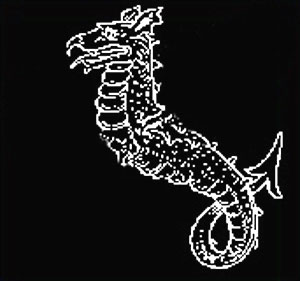
Tiamat?
Before you toss out the idea as
ludicrous, consider that Enki's E.ABZU "ziggurat" (if you can really
call it that), was entirely made of metals, talked, floated,
hovered, made "roaring" sounds, glowed so brightly it lit up the
area, had an interior that was,
"a tangled thread beyond
understanding," had a door that "seizes a man", was connected to
the Field Constellation, and gave advice!
This was not an ordinary ziggurat, in
fact, it was one of the first prototypes for all subsequent
ziggurats, after the flood. However, the subsequent buildings did
not have interiors that were "tangled threads beyond understanding!"
Let's look at the picture again:
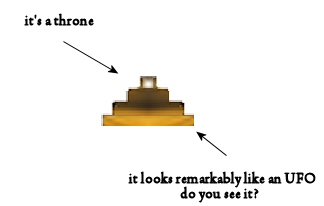
Enki's Ziggurat
Do you notice anything unusual about the
shape of the ziggurat? If not, allow me to point out a few things:
It was the prototype for not only later ziggurats, it was also the
prototype for earthly "thrones" of glory, such as the throne of the
Emperor of China:
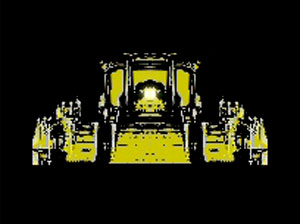
The Golden Dragon
Throne
This leads us to the next question: so
why and how would the god Enki build a space craft in ancient Eridu?
From the textual evidence, it doesn't appear as if it was built in
Eridu, but rather it came out from somewhere in the ABZU.
It was
already "built" when it rose out of the ABZU, and I quote:
"An artfully made bright
crenellation rising out from the abzu was erected for lord
Nudimmud." [2]
It simply rose up from the ABZU and
planted itself on the spot. It "landed."
Samuel Noah Kramer also describes this
event, saying,
"Then Enki raises the city of Eridu
from the abyss and makes it float over the water like a lofty
mountain."
It could be argued that the story is
really just referring to the construction of the building, "rising"
up as it was being built.
If such is the case, he apparently built
it from a model of something else he was intimately familiar with
and endowed it with some technically advanced features, considering
the time frame!
After all, how many of the post-flood
ziggurats were composed "entirely of silver" (those bricks weren't
just glazed with silver, they were "entirely" silver, covered with
gold) and could "float?"
Answer: none, as the post-flood ziggurats
were simple mud brick constructions, crude copies of the original,
which appears to have been a spacecraft and water-going vessel of
glowing metals!
And, this is just the beginning!
Now, let's look at the
technological aspects of the ABZU's counterpart, the dragon or
Tiamat...
Footnotes
1 - Ancient Sumer was the first
civilization on the planet (to date). It was ushered in by
the
Anunnaki, who taught the people music, the sciences, astronomy,
languages (both spoken and written), mathematics, herbology,
manipulation of the environment, hybridization of crops, genetic
manipulation of livestock, religion, sexual promiscuity, war,
mining for resources, jewelry-making, tailoring, blacksmithing,
architecture, art, poetry, human sacrifice, and the whole gamut
of "civilized behaviors."
2 - Enki's journey to Nibru: translation, The Electronic Text
Corpus of Sumerian Literature. Black, J.A., Cunningham, G.,
Ebeling, J., Flückiger-Hawker, E., Robson, E., Taylor, J., and
Zólyomi, G., The Electronic Text Corpus of Sumerian Literature
(http://etcsl.orinst.ox.ac.uk/), Oxford 1998
3 - "Tiamat." Encyclopedia Mythica from Encyclopedia Mythica
Online. [Accessed February 24, 2006].
4 - Enki and the world order, Black, J.A., Cunningham, G., Ebeling,
J., Flückiger-Hawker, E., Robson, E., Taylor, J., and Zólyomi,
G., The Electronic Text Corpus of Sumerian Literature (http://etcsl.orinst.ox.ac.uk/),
Oxford 1998- . The Electronic Text Corpus of Sumerian Literature
"The
Dragon on His Throne"
You cannot teach a man anything;
you can only help him discover it in himself.
- Galileo Galilei
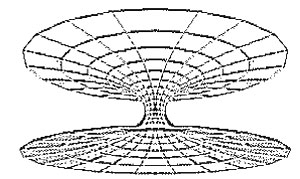
A Wormhole
Consider this quote from the ancient
text entitled, "Enki and the world order":
"Grandiloquent lord of heaven and
earth, self-reliant, father Enki, engendered by a bull, begotten
by a wild bull, cherished by Enlil the Great Mountain, beloved
by holy An, king, mec tree planted in the Abzu, rising over all
lands; great dragon who stands in Eridug, whose shadow covers
heaven and earth, a grove of vines extending over the Land, Enki,
lord of plenty of the Anuna gods, Nudimmud, mighty one of the E-kur,
strong one of heaven and earth!
Your great house is founded in
the Abzu, the great mooring-post of heaven and earth" [1]
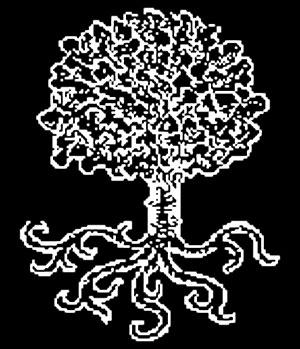
The mec tree planted in the ABZU.
A
grove of vines rising over all the lands. The great mooring-post of
heaven and earth.
Obviously, this is not referring to a
simple ziggurat, and isn't it amazing that it also embodies "As
above, so below?"
Notice how, in this particular tale, Enki is referred to as the
"great dragon?" Was he literally a dragon? Perhaps, in a manner of
speaking, he was. But remember, later, Tiamat would also be called a
"dragon," who connected a place in the "Field" constellation
[1a], to planet Earth.
Since Tiamat was part of the "star-gate" system at Enki's E.ABZU, of which he claimed ownership, it
seems likely that he was simply being referred to, in a dramatic
way, as the owner of said property.
After all, he wasn't literally a wild
bull or begotten by a wild bull and yet, that's exactly what's
indicated in the texts. Rather, he was called the Great star-gate,
the Great Tiamat, the Great Wormhole, the Great Dragon,
symbolically, as its owner and operator.
Of course, he may have also been from a
race of extra-terrestrial beings who appeared rather "Reptilian".
It might be pertinent to mention here that a specific group of
angels, in the biblical texts, called "Seraphim," were serpent-like
in appearance. Several authors have noted textual similarities
between Enki and the biblical Satan, the "Serpent" or "Seraph" in
the Garden of Eden. So it is possible the reference to Enki being
the "great dragon," may have more than one application.
For example, it's no small coincidence
that Enki as the biblical Satan is, in this metaphor, a "dragon" or
"serpent" in the "tree."
Also consider that the great dragon "stands" in Eridu(g) like the "mec
tree," which is likely a reference to the wormhole with all its
"branches", a grove of vines rising over the lands and also buried
in the earth beneath the E.ABZU, like the root system of a huge
tree.
For example, reconsider the opening image on this page:

A Wormhole
How similar it looks to a tree with its
branches spreading across the heavens and roots digging into the
earth.
Still skeptical? Don't believe in the scientific possibility of
wormholes?
Allow me to provide evidence for your consideration:
Wormholes or white holes, are shortcuts, connecting distant points
in space-time. Mechanically, they appear as double-ended, whirling
vortexes, flared at each end and embody the hourglass shape:

Over the last few decades, there has
been quite a bit of debate over whether such a wormhole is
physically possible. The amount of energy to sustain it, physicists
argued, would be too immense and the passageway would collapse on
itself in micro-seconds.
However, in the last 5 years, the
original arguments have been met with new findings, such as this
one, reported in
BBC News on April 12, 2000:
According to Sergei Krasnikov of the
Pulkovo Observatory in St Petersburg, the new wormhole can
create its own abundant supply of exotic matter. This way, the
wormhole would be big enough and could stay open long enough for
people to use.[2]
"What's new is that this wormhole actually generates enough to
make it arbitrarily large," says Krasnikov who works at the
Laboratory of Stellar Physics.
In 2005,
a new argument arose against
practical wormhole usage, but was immediately contested:
Calculations by the Oregon
researchers show a wormhole that combines exotic matter with
semi-classical space-time would be fundamentally unstable.
"We aren't saying you can't build a wormhole. But the ones you
would like to build - the predictable ones where you can say Mr
Spock will land in New York at 2pm on this day - those look like
they will fall apart," Dr Hsu said. [...]
However, there is still support for the idea of traversable
wormholes in the scientific community. One physicist told BBC
News there could be problems with Hsu's and Buniy's conclusions.
[...]
"Violations of the null energy condition are known to occur in a
number of situations. And their argument would prohibit any
violation of it," the scientist commented. [...]
The underlying physics of wormholes was not in doubt, the
researcher argued. The real challenge was in explaining how to
engineer wormholes big enough to be of practical use. [3]
So, theoretically, the traveler enters
one end of the vortex and emerges on the other end.
Another way to represent it is like
this:

Notice how it's flared at both ends and
thinner in the middle, which is called the "throat" of the wormhole
(the throat or neck of Tiamat is usually depicted much shorter in
length, but represents the distance between one point and another,
or rather, between one star-gate and another).
Turned on end, it takes on the
characteristic shape of the hourglass, the "As above, so below"
symbolism, and the mec tree of the great dragon.
Marduk of Babylonian fame, invited the gods to visit him in Babylon,
his "Gate of the Gods," as they employed the gates between earth and
heaven. It is believed he was partially quoting earlier stories
about the ante-diluvian gods, as he had also absorbed their tales
and activities, claiming them to be his own exploits.
It is also believed, per the biblical
accounts of the flood, the Tower of Babel, and the bottomless pit of
Revelation 9, that the star-gate or bottomless pit entrance at Eridu
has been buried for thousands of years. If it has been dug up since
then, it isn't likely that the general public would be made aware of
it.
All these ante-diluvian symbols of Anunnaki technology, became
religious icons, religious buildings and religious symbols following
the flood. The mec tree or wormhole of the great dragon
became the sacred tree on the temple grounds of Mesopotamian
temples. In essence, the Tree containing the Serpent in the Garden,
had been immortalized on the sacred grounds of the temples of
Akkadia and Babylon without the people ever fully realizing its
meaning.
The ABZU or stargate, became the
primeval waters symbolized in the sacred pools or sacred water
receptacles for ritual bathing in temples in the near and middle
east. Enki's floating, speaking and flying palace, called the E.ABZU,
became the model for ziggurats, pyramids and earthly thrones of
power.
And the hourglass shape, which defined
the shape of the dragon, the wormhole and Tiamat, became a symbol
for the power of the holy mountain, the power of the ziggurat and
pyramid.
However, of special note is the hourglass symbolism represented by
"Mt. Sumeru" or "Mt. Meru," of ancient Hindu and Buddhist history,
which is depicted as a mountain formed in an hourglass shape.
According to the mythology surrounding it, Mt. Sumeru has its roots
in hell and its upper reaches in heaven.
Upon the death of Buddha, it is said
that Mt. Sumeru was broken in two at the intersection between the
two triangles of the hourglass, breeching the connection between its
upper, heavenly levels (the upper, downward pointing triangle) and
the earthly levels (the lower, upward pointing triangle).
In effect, the wormhole had been severed
at the throat, the dragon Tiamat had been slain, cut off at the neck
or cut in half (an event further elaborated on in the
Enuma Elish), the bottomless pit
had been rendered useless and buried.
Enki's "star-gate", however, was not the only one. In fact, his
Sumerian brother, "Enlil," also appears to have had his own "Abzu",
which is the subject of the next page!
* (Note: For
further clarification on this topic, read
The Enuma Elish and the free
e-book,
The Anunnaki and the Abyss.
Footnotes
1 - Enki and the world
order, Black, J.A., Cunningham, G., Ebeling, J., Flückiger-Hawker,
E., Robson, E., Taylor, J., and Zólyomi, G., The Electronic Text
Corpus of Sumerian Literature (http://etcsl.orinst.ox.ac.uk/),
Oxford 1998 - The Electronic Text Corpus of Sumerian Literature
1a - Enki and the world order, Black, J.A., Cunningham,
G., Ebeling, J., Flückiger-Hawker, E., Robson, E., Taylor, J.,
and Zólyomi, G., The Electronic Text Corpus of Sumerian
Literature (http://etcsl.orinst.ox.ac.uk/), Oxford 1998- . The
Electronic Text Corpus of Sumerian Literature
2 - "Wormholes take on a new
dimension", BBC News, April 12th, 2000.
3 - Paul Rincon,"Wormhole 'no use' for time travel", BBC
News, May 23rd, 2005.
"The Heaven-Earth Bond"
Somewhere, something incredible
is waiting to be known.
-
Carl Sagan
In the Sumerian city of Nibru (Nippur),
Enki's brother Enlil held court. He also had a marvelous
construction called the E.KUR, which is depicted in the Sumerian
text, "Enlil in the E.KUR."
As in the case of Enki's "E.ABZU," the
E.KUR was quite an unusual construct.
For example:
He has taken up residence in Nibru,
the lofty bond between heaven and earth. [...]
The front of the city is laden with terrible fearsomeness and
radiance. [...]
Its brickwork is red gold, its foundation is lapis lazuli. [...]
Its interior is a wide sea which knows no horizon.[...]
Its fearsomeness and radiance reach up to heaven, its shadow
stretches over all the foreign lands, and its crenellation
reaches up to the midst of heaven.[...] [1]
In modern terms, this building has
several surprising features!
It is a bond between heaven and earth.
It features a radiant facing or cover, which reaches up to heaven,
like some ancient force-field. It's made of, or the color of, red
gold with a blue foundation. And for the clincher, the inside of it
is a "wide sea which knows no horizon"!
That's certainly an
interesting way of describing an Abzu star-gate - a wide sea which
knows no horizon. Of course it knows no horizon, after all, it's a
star-gate not the sea!
To further signify its connection to the Abzu as an underground
star-gate chamber, consider the following quote from "Enlil in the E.KUR":
Enlil, holy Urac is favored with
beauty for you; you are greatly suited for the Abzu, the holy
throne; you refresh yourself in the deep underworld, the holy
chamber. [1]
Apparently, the word "Abzu" was used
interchangeably for all the subterranean star-gate chambers. In
fact, this very thing is depicted in ancient Egypt!
Few realize that the ancient Egyptian
city name of "Abydos" is in fact not an Egyptian word at all. It's
Greek.
The Egyptian word for it is "Abdju," pronounced "Abzu", as
described by Peter Goodgame in his book, "The Giza
Discovery":
One of the first important cult centers for the invaders of Egypt
was a place which came to be known by the Greeks as "Abydos."
However, the Egyptian name is better represented as "Abedjou" or "Abdju."
The sound "dj" is often simply given as "z," such as in the common
rendition for the Step-Pyramid of Djoser as "Zoser."
With this in mind we find that Abydos=Abdju=Abzu,
which directly equates with the cult center of Enki known as the
Abzu in Eridu.[2]
As a result of this discovery, the next logical step was determining
where the subterranean star-gate chamber was in ancient Abydos (Abzu),
Egypt. And one need not look far to find it. It's called the "Osirion"
and its archaeological history, since its discovery, has been
shrouded and emerged in controversy (as you can well imagine!).
After all, "Abzu" was a Sumerian concept
and word, and yet here it is in one of the earliest cult cities of
ancient Egypt.
Anyway, we find that Enlil was also in possession of a star-gate and
an Abzu chamber to put it in. The name of his chamber and star-gate,
however, was not simply Abzu, it was additionally called the "Dur.Anki",
the "Heaven-Earth Bond."
It also spread its shadows across the
heavens, across the foreign lands. It also reached up to heaven from
beneath the earth, as is indicated in its name as the "heaven-earth
bond", also known as the bond of the universe (heaven and earth).
The argument that the heaven-earth bond was simply a reference to
the E.KUR being high enough from which to observe the heavens, is
rather weak in the face of the surrounding evidence, such as the
mountain ranges and cliffs in the vicinity of Enlil's E.KUR.
Certainly any nearby mountain would be much closer to "heaven" than
a ziggurat construction.
As a result, I find such arguments
sorely lacking in validity in the face of the data regarding the
terrain and the geographical setting of this ancient structure. In
short, the heaven-earth bond, is simply that, a bond of some sort
between heaven and earth! In fact, it harkens back to the opening
concept of "As above, so below."
Remember, Mt. Sumeru of the ancient
Hindu and Buddhist texts, which was likely named after the E.ABZU or
E.KUR of Sumer, was a connection between the depths of the Earth and
the heights of the heavens - clearly indicating it to be some kind
of portal of travel.
So, what, you might ask, happened to these Sumerian star gates? Find
out in the next chapter, "The Akkadian Connection!"
Footnotes
1 Enlil in the E.kur
2 The Giza Discovery: Part Five, The Spirit World and
Civilization-The Egyptian Connection
"The Tower of Babel and The Fertility Gods"
One possible geometry for such a
wormhole is to assemble stellar amounts of energy in a
spinning ring (creating a Kerr
black hole). Centrifugal
force prevents the spinning ring from collapsing.
Anyone
passing through the ring would not be ripped apart, but
would wind up on an entirely different part of the universe.
- Michio Kaku
Osiris [1]
Footnotes
1 Ancient Egypt -
KingTutOne.com a Resource
Center for Ancient Egypt
|








